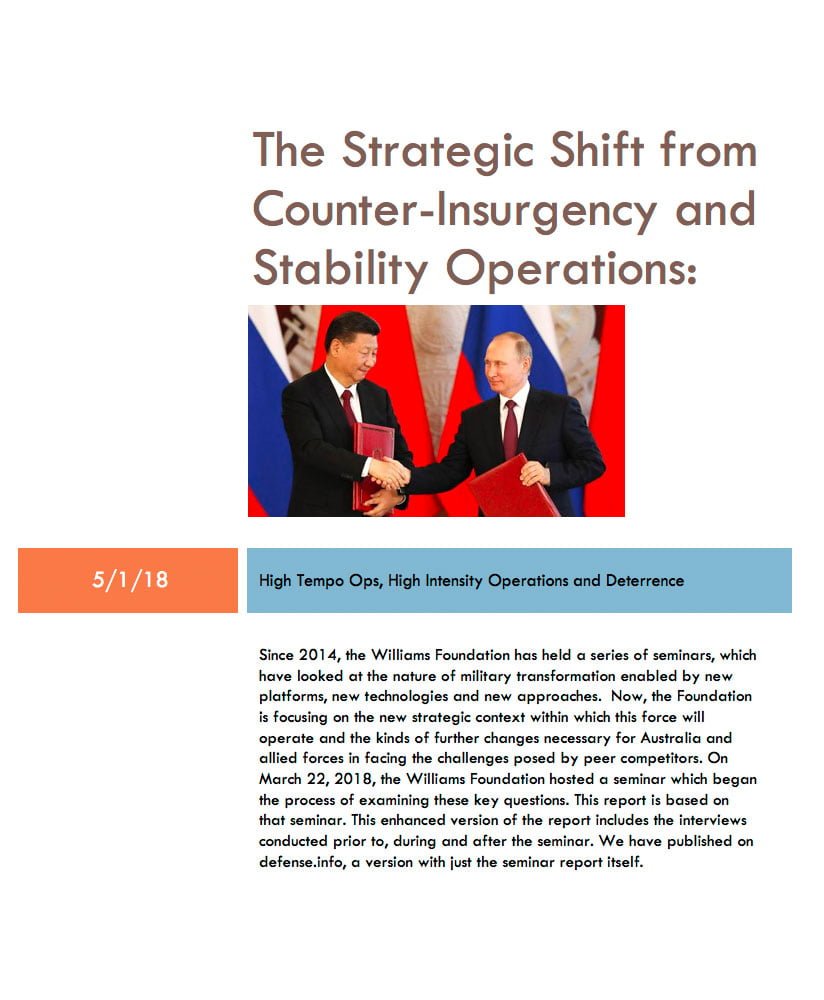Since 2014, the Williams Foundation has held a series of seminars, which have looked at the nature of military transformation enabled by new platforms, new technologies and new approaches.
Shaping of a fifth generation warfare force has been at the heart of the conversation, and the challenge of crafting, shaping and building a more integrated force has been a core focus.
Building a more integrated force is required to operate with more flexibility, more scalability, and with more effectiveness, using either kinetic or non-kinetic means. This force needs to be more integrated because it needs to operate in a multi-domain space to achieve combat effectiveness, and to achieve strategic objectives set by the political leadership.
This year the Williams Foundation has shifted focus to look at the demand side of the equation. The Foundation is focusing on the new strategic context within which this force will operate and the kinds of further changes necessary for Australia and allied forces in facing the challenges posed by peer competitors.
On March 22, 2018, the Williams Foundation began the process of examining these key questions. The Williams Foundation laid out the following narrative in preparing the seminar along with the following questions:
Most Air Force and senior military leaders in the western world begin their military careers either around or shortly after the Falkland Wars which were watched globally as an epic air, sea, and amphibious campaign; conventionally fought at the ends of the earth and at the end of an immense supply chain for the British Forces.
The decades that followed saw warfare in the Balkans and Middle East, and counter insurgency operations in Afghanistan; warfare very different from that postured for during the cold war and exercised in high end air combat exercises.
The Australian Defence White Paper 2016 and the associated Force Structure Review was written to an Office of National Assessment Strategic Environment to 2035 against this paradigm, whilst recognizing impending change. The subsequent rate of change in global security has shocked even pessimistic observers and we face the heightened risk of high intensity, non-permissive air environments non-discretionary wars.”.
Questions to be addressed at the Seminar
What will be the impact on the delivery and expectation of 5th Generation systems as the world has changed so dangerously and so rapidly?
Have hostile forces been watching the development of our 5th generation systems and developed active asymmetry to defeat us?
Has the combination of our cold-war legacy and participation in irregular wars led us to make decisions that will limit our freedom of movement?
As we rediscover the concept of denied area (A2AD / beyond FEBA) and need to re-invest in strike capabilities, are there areas of concern? [Range / Payload / Escort requirements / requirement to step non fast-air platforms / risk of hypersonic AD systems] [Basing options / Life Support / Force Protection / Multi-domain threats]
Do we need to reconsider air campaigns in the light of Joint Force / Joint Strike options?
Do our national systems support the requisite battlespace awareness in denied areas to conduct effective targeting and effect generation?
Presentations by senior Australian and allied military leaders along with those by civilian analysts provided a solid foundation for understanding the challenges and how profound the shift will be for the liberal democracies in the period ahead.
Future seminars will address the question of what capabilities need to be added to the Australian and allied forces to deal with the strategic shift as well as how those forces can train more effectively to deal with the new challenges.
It is clear that the kinds of peer competitors the liberal democracies are dealing with are engaged in broad political conflict with the liberal democracies. They are crafting a range of tools to disrupt and to influence domestic policies in the liberal democracies.
It is also clear that the presence of Chinese and Russian economic interests in the liberal democracies provide a much broader opportunity than in the days of the Cold War to both establish and expand influence within our societies.
And the evolving tool sets associated with a core activity like information war or cyber conflict is designed not only to help competitors now but will be used in enhanced ways in the shape of any future high intensity conflict. They are already attacking our civil societies.
We are not facing an abstract future warfare scenario; we are already engaged in information war and cyber operations are being directed against the liberal democracies. These operations are certainly designed as well to undercut the cohesion of the liberal democracies to work against the interests of the illiberal powers.
A core point made at the seminar was that dealing with peer competitors was not just about preparing for an abstract future high intensity conflict but about dealing with various elements of a force already engaged against us.
The bulk of the seminar focused directly on the challenges of remaking the force to deal with higher tempo operations and possible direct high intensity conflict.
Certainly, a key argument made throughout was that many habits learned in the the counterinsurgencies and stability operations of the past two decades would need to be modified; notably, notably that we can operate with air superiority and have information security as a given.


